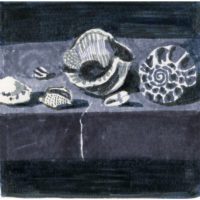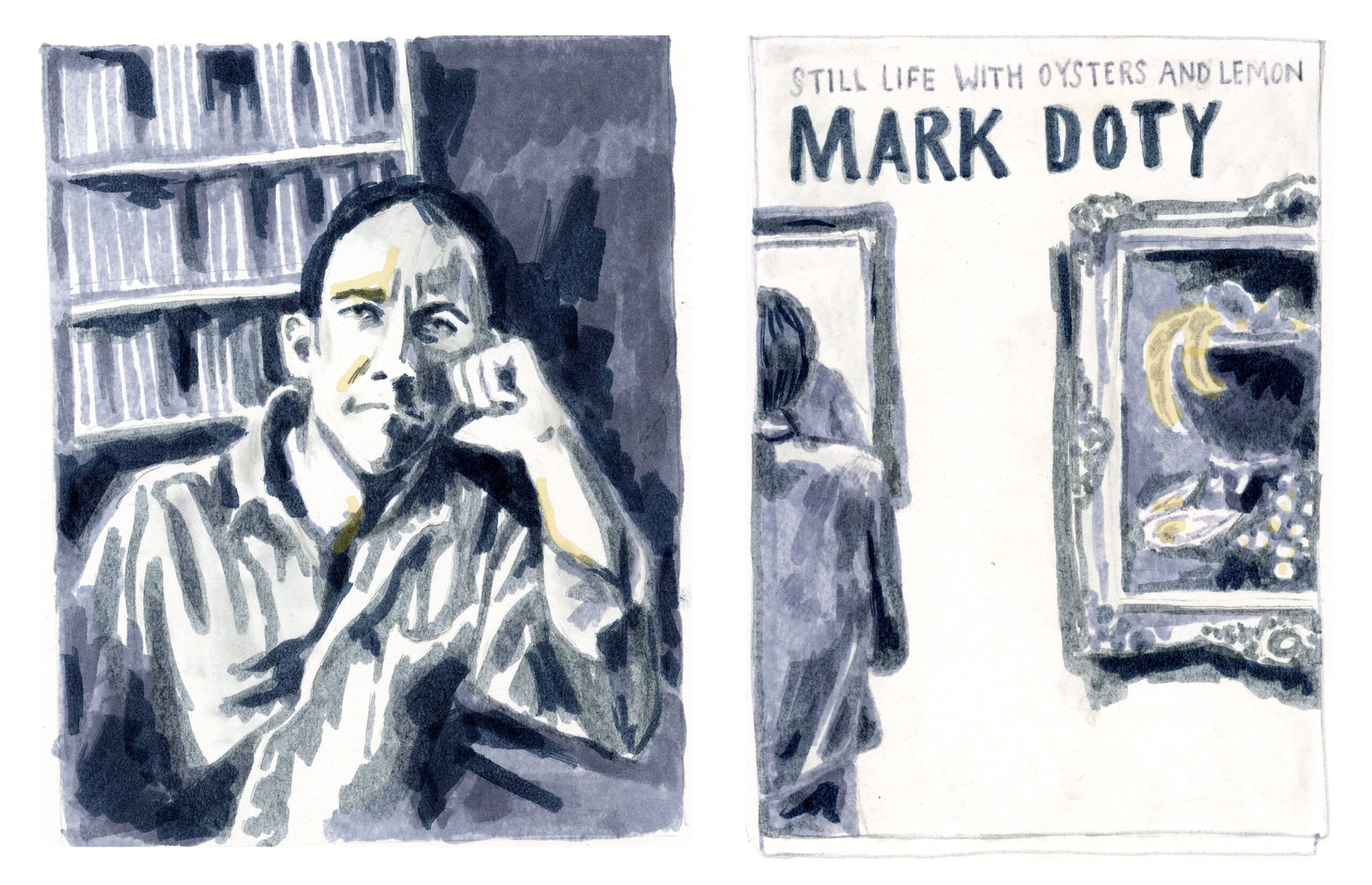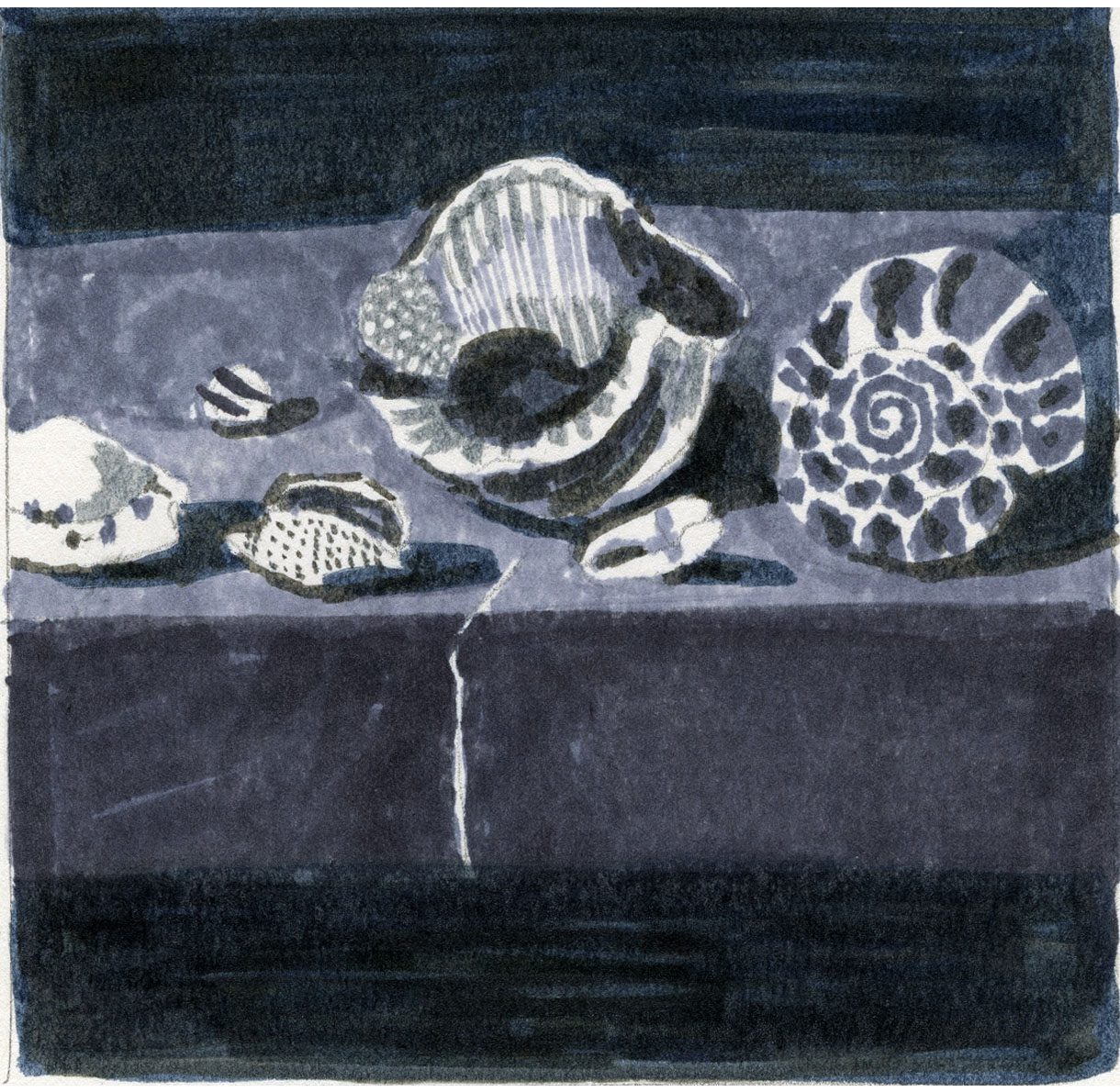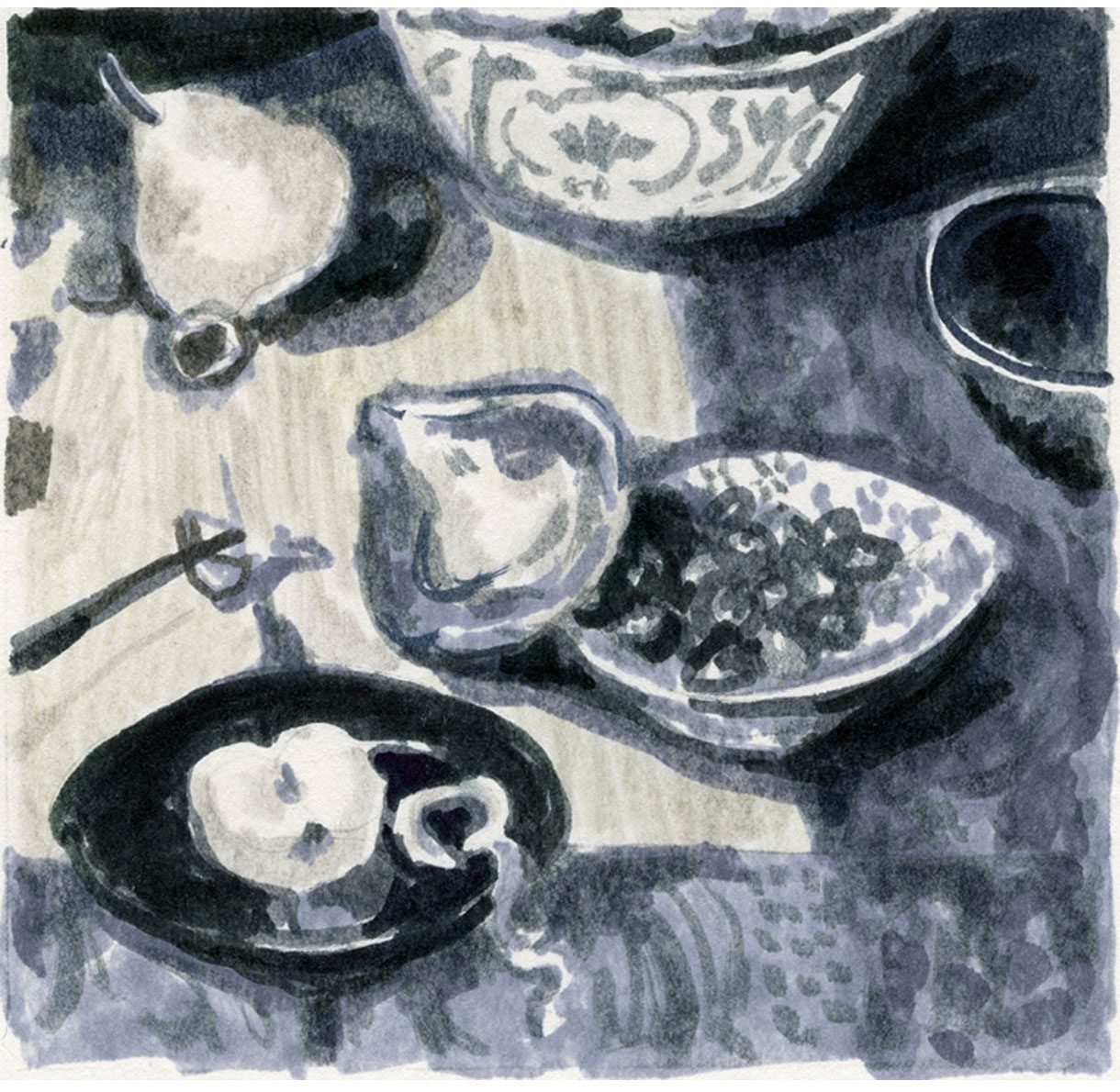I spent the last year of graduate school meeting weekly with four other writers in our professor’s house on faculty row, a street of low-slung brick houses a short walk from campus. My professor was the novelist Carrie Brown. At Carrie’s house, there was always a steaming kettle on the stove, mugs out and ready for tea, a batch of muffins or shortbread just pulled from the oven. When it was time for class, we’d settle on two red couches near the fire and take turns reading aloud—first essays by writers we admired, and then our own, trying not to measure with too much precision the distance between the two.
At our final class before graduation, we sat around Carrie’s dining room table. She produced a seemingly endless array of food and we talked for hours, urgently, as if we could stall time, keep the moment—and the class—from ending, hold graduation at bay, delay the coming days when no one would care whether we finished that draft or submitted anything to a journal or experimented with some new form or style. When Carrie took a long, slow inhale, we all went quiet.
“Writing will never leave you,” she said, and looked around at each of us, our anxious faces colored by candlelight. “There may be days, months or years from now, when you have your discipline, your set-aside writing time, an hour here or there or every day that’s carved out just for writing. And one day your kid shows up at the desk beside you and says, I’m hungry. You don’t say, Hey, kid, it’s my writing time—come back in an hour. You get up. You make your child a snack. You try again next time.”
She pushed her chair back from the table and stepped away from us, returning with five copies of Mark Doty’s Still Life with Oysters and Lemon: On Objects and Intimacy—a slim book, less than one hundred pages—and set a copy before each of us. Before we could get too maudlin, she shooed us from the house, refusing help with the dishes, hugging each of us in the doorway before sending us out into the night. It was a twenty-minute drive home, past the mountains silhouetted against the darkened sky, and I sobbed the whole way.
In the months following graduation, every time I picked up Still Life with Oysters and Lemon, I never got far beyond the opening lines: that “sharp crackling cold day” on the Met museum steps. Doty’s back is hurting, he tells us, he is weary from traveling, from being surrounded by crowds of tourists, but none of this matters, because he has fallen in love with a painting:
…that phrase doesn’t seem to suffice, not really—rather it’s that I have been drawn into the orbit of a painting, have allowed myself to be pulled into its sphere by casual attraction deepening to something more compelling. I have felt the energy and life of the painting’s will; I have been held there, instructed. And the overall effect, the result of looking and looking into its brimming surface as long as I could look, is love, by which I mean a sense of tenderness toward experience, of being held within an intimacy with the things of the world.
And there, halfway through the book’s second page, I would give up, closing the book and tucking it away on a shelf. Every time I read this paragraph, I felt a creeping, ugly envy, not only for Doty’s transformative experience with art, but for his languid inward circling, his language leading steadily inward toward poetic precision. In his patient honing of language, allowing it to do its unfolding, deepening work, I could sense that ingredient so essential to good writing—time—a resource I’d had access to so recently, but could not seem to get back.
I was working a string of meager part-time jobs—teaching writing workshops online, selling buckets of popcorn at a movie theater, tutoring kids at an expensive private school, editing novels and articles for other writers. I didn’t know how to feel “held within an intimacy with the things of the world” when I spent most days trying to get away from the world, to remove myself from it, to spend an hour or two in quiet, hunched over my journal or a book at my worn kitchen table.
Time had become an unseen, muscular force I could sense along the edges of any piece of writing I admired. I knew without making more time to write, I couldn’t do more than jot down what I saw each day—nothing beyond noticing, that bare minimum. Anytime I was not writing, I was thinking about writing: between show times at the movie theatre, I sat in the box office and read whatever book I’d brought with me, took fractured notes on receipts as I printed customers’ tickets. When I did nab an hour or two to write, I found I’d been so anxious about writing, so absent from the world, that I didn’t know what to say about it anymore. Within this absence, Doty’s book hurt most. Still Life was a reminder not only of how painfully distant I felt from the world, from my senses, but how painful it was to return, to see all I’d missed.
It was not until nearly four years after that last tutorial at Carrie’s house that I was able to read Still Life with Oysters and Lemon in its seventy-page entirety. I don’t know what made me reach for Still Life once more, years after Carrie handed copies out over her dining room table, other than that it had become a tradition for me, a way of checking in. Was I ready to read this book, now? After all this time? No, was always the answer, until one day it wasn’t anymore. By then, I’d left Roanoke and moved back home. I’d been out of grad school longer than I’d been in it. I had a full-time job and a mortgage and a husband and an ailing grandmother to care for and no more time than I’d had in those first months after school ended.
The tension I’d felt, between writing and the world, seemed only to be growing stronger: driving my grandmother to one of her friend’s funerals, my mind tallied all the writing I’d not done that week, consumed with what I would write if only I could escape these obligations. Finally home, with some quiet time to write, I couldn’t bring my mind to the page and away from the image of my grandmother hunched in the passenger seat, or her shaking, mottled hands clenching mine as we walked into the funeral home.
When I reached for Still Life again, if nothing else, I wanted to know what message Carrie might have imparted in the choice of this book. Out of all the books in the world, she chose Still Life with Oysters and Lemon as her parting gift, and I wanted to know why. I read the book in tiny pieces—two or three pages at a time—inching through like Doty making his painstaking way through an exhibit in an Amsterdam museum. The text moves between descriptions of Dutch still life paintings and brief, highly descriptive passages revisiting loved ones through the objects that seem, through Doty’s crystalline vision, to somehow embody them.
Doty’s central claims about the emotional power of objects and the necessity of a descriptive language grounded in the world are embodied by the text itself, which revisits the “instructive, resonant thing[s]” of Doty’s life: the peppermints his grandmother fished from her black leather pocketbook; the wig his mother-in-law wore in the final days of her illness and her bed pushed out on the back porch once she could no longer climb the stairs; the chipped blue and white platter Doty bought at a yard sale because it reminded him of his mother, and which Doty’s partner Wally hung above the mantle, and which, after Wally’s death, did not look right anywhere else in the house.
These objects taught Doty how to love the world, and his descriptions demonstrate his argument: that the language of ideas is “a phantom language, lacking in the substance of worldly things, those containers of feeling and experience, memory and time”; that memory does what art does, “which is to take the world within us and somehow make it ours”; that description, borne of outward attention to the world, ultimately gives us back ourselves.
I read Still Life with forbearance, waiting to see some weakness reveal itself, waiting to sense some part of the inner scaffolding collapse. But each sentence seemed to simultaneously articulate Doty’s argument and arrive at the proof, leading sentence by sentence to a whole that is somehow more than a book, something more solid, an art object of its own.
In this way, Still Life is a literary onomatopoeia, sounding exactly like the thing it describes, and my reaction to the book reminded me of the way my grandmother might tell me about a new baby at church: she wanted to nibble those tiny toes, or take a bite of those apple-red cheeks—she could, she’d say, “just eat him up.” Still Life is so beautiful I want to ruin it, devour it. I don’t know how else to say it—reading Still Life hurt. It was painful to be reminded of the fullness of the world, when it seemed I could glimpse only its surface.
I could never read more than a few pages without reaching for my own journal, to write a line down that I didn’t want to forget, or to record a memory of my own that the book somehow brought to mind. Doty’s observant eye seemed to heighten my own vision, helping me pay attention to the world when it often felt easier to allow myself to glide through it, glazed-over. Over time, I started to read Still Life like a devotional text. Instead of reminding me of all I was missing, the book became a talisman for bringing me back to the world.
Standing in line waiting to vote in a dim church hallway, feeling my mind go fuzzy, aware of the glowing blue screens reflecting on the downturned faces on either side of me in the long line, I’d pulled Still Life from my bag to find the world given back to me in the description of a painting of five seashells:
Each one is completely unlike the other, in color and in form. This one is vulval, this one whorled, this tiny whelk is turned away from us, its opening hidden; this snail is the color of cochineal… This is a poem of difference, of strangeness: here, the painter says, are five things, five from the same category, and look how unalike they are, what dreamy variety the world offers up.
Then the lady at the door of the polling place said, “Next,” and when I looked up from my book I found I could see the world in all its dreamy difference—the faces around me, puckered and bearded and creased, our weary bodies leaned against the cinderblock walls. A man walked in, breathing heavily and leaning on a walker, and several of us at the front of the line called out for him to skip us, to take our turn.
Doty published Still Life with Oysters and Lemon in 2001, and in the book’s final pages, he addressed the moment in which he wrote, a moment of turmoil and uncertainty and violence much like our own: “I know that all of this might be taken as precious,” Doty writes, “a hymn to so much useless beauty, in an hour when the notion of beauty is suspect—when it seems to suggest a falsely bright view of the world, or a narrow set of aesthetic principles related to the values of those in power, an oppressive construction.”
But art does not belong solely to museums, and does more than buttress some arcane aesthetic hierarchy—art reminds of the infinite varieties of the world and those who make record of it, binding us all together as “a community of attention-giving,” allowing us to be, as Doty says, “both here and gone,” “someone and no one,” reminding us that beneath and among layers of ego and identity, “what we are is attention, a quick physical presence in the world, a bright point of consciousness in a wide field from which we are not really separate.”
At first, Carrie’s promise that writing would never leave us was a conciliatory mantra I repeated to myself on days that went by so quickly I’d barely had time to think, much less to notice the intricacies of any hour before it passed. Maybe you didn’t write today, but writing will never leave you, I’d say to myself as I drove from my second part-time job to the third. But as I finally read Still Life with Oysters and Lemons, the meaning of Carrie’s promise seemed to shift. Her promise was not only that writing would be there for us for the rest of our lives, a place we could return to no matter how long our absence, but it also granted us permission to live those lives, to be present in them, to think of life and the world as the real thing, not as an interruption from writing. Writing existed within our lives, not the other way around.
Still life paintings reminded Doty that all attempts to “draw nearer” to the world—through descriptions or representations, writing or art—are destined to fail, but not entirely. The attempt to describe the world will, after all, give us not the world itself, but something else—a painting, a poem—imbued with something of the world and something of the person who made it. “What is documented, at last, is not the thing itself but the way of seeing…” In any person’s attempt to describe the world, we are necessarily given some part of them, their presence: “the eye moving over the world like a lover.”
When I think of Carrie’s house, I wander the rooms as I remember them: the framed broadsides printed on deckled-edge paper hanging askew in the foyer, the extra copies of her own hardback novels stacked on the mantle, ready to take with her to readings or give out as gifts, the woven basket filled with kindling for the fire, the red upholstered couches facing each other, the tray holding the small wooden boxes filled with packages of tea, the glass kettle on the stove always on the edge of boiling, the orchids in the kitchen windowsill and the condensation clinging to the pane, the bird feeders by the back door where we stood and watched night roll over that tiny mountain town.
None of it remains. In the weeks following our last class, Carrie moved away, and within a couple years, the entire row of faculty housing would be bulldozed—all those small brick houses cleared for a new dorm. But these places, these objects, so readily returning to my mind, still bear all the charged memories of that time and place, all the tenderness with which we held each other for that year, and the searing knowledge we all shared but never uttered—that this place, this time, was rare, and we might not get the chance again to be seen with such clarity, or be held with such care, or be given the gifts that would, ultimately, give us back ourselves.
***
Original artwork provided by author.







